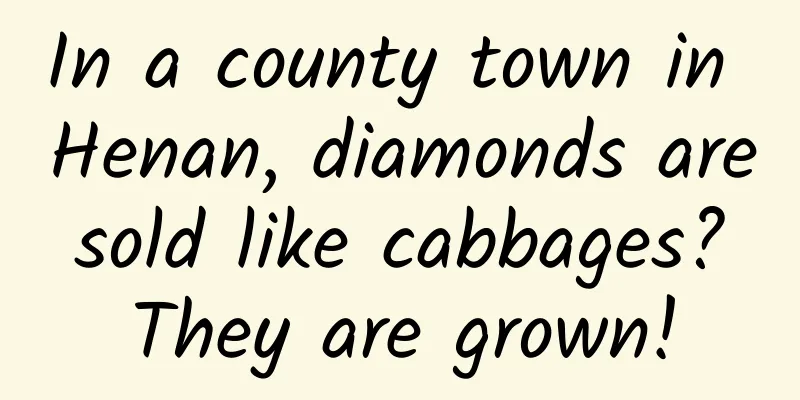In a county town in Henan, diamonds are sold like cabbages? They are grown!

|
At the beginning of this year, the cultural and tourism bureaus in various parts of China have been busy with various activities, and many local "local specialties" have entered the public's field of vision. Luoyang, Henan Province, was even more amazing, giving tourists diamonds generously , the largest of which was 1 carat, and 100 diamonds were given out in one day! For a while, netizens had a lot of questions in their heads - isn't Henan a major agricultural province? When did its specialty become diamonds? The picture comes from the Internet In fact, Henan is not only good at growing crops, but also has a history of "growing diamonds". 80% of the world's artificial diamonds come from Henan , especially in Zhecheng County, Shangqiu City. Are artificially grown diamonds real diamonds? “A diamond is forever.” This is the most familiar diamond advertisement and is also regarded as the most successful advertisement in the 20th century. Because of its dazzling brilliance and its close association with love and marriage, diamonds have always been in everyone’s sight despite their high prices. Wouldn’t it be ideal if diamonds could still shine, but at a price far lower than today’s ? That’s when artificially grown diamonds come into play. The English name of cultured diamond is “lab grown diamond”, which literally means artificial diamond grown in a laboratory. Are they real diamonds? Of course they are! Diamond is a gem-grade diamond, composed of nearly pure carbon, and is an allotrope of carbon substances such as graphite. Inside the diamond crystal, each carbon atom is tightly bound to the four surrounding carbon atoms, forming a special three-dimensional structure that is not seen in other minerals. It is this dense structure that makes diamond the hardest mineral in nature. Comparison of the structures of diamond and graphite. Both are made of carbon atoms, which is why we can make diamonds from graphite. Image source: wikimedia Like natural diamonds, cultured diamonds are crystals made of pure carbon atoms. There is no essential difference between their crystal structure, physical properties, chemical properties, and optical properties. An expert vividly described the difference between the two: " The difference between natural and artificial is like the difference between ice in a river and ice in a refrigerator ." Cultivated diamonds can be certified by the three major diamond certification agencies, which shows that their status as real diamonds has been officially recognized. In 2018, the US Federal Trade Commission adjusted the definition of diamonds and classified cultivated diamonds as a general category of diamonds for the first time. How are diamonds grown? Natural diamonds are buried deep in the earth. They are carbon-containing minerals and a certain proportion of iron metals. They take hundreds of millions of years to form in an oxygen-free environment at high temperatures of 900°C to 1300°C and high pressures of 45 to 60 kPa. Natural diamonds take a long time to form and are very expensive to obtain. However, artificially grown diamonds only take weeks or even days to produce gem-quality diamonds . At present, there are two main methods for growing diamonds: one is High Temperature and High Pressure (HPHT) technology ; the other is Chemical Vapor Deposition (CVD). High temperature and high pressure technology is the mainstream diamond cultivation technology in China, especially concentrated in Henan. The main instrument is a six-sided top press . The synthesis process is to put a graphite column wrapped with graphite powder, diamond seeds and metal catalysts into an ultra-high temperature and high pressure reaction chamber. The graphite powder is catalyzed by the metal catalyst powder and crystallized on the seeds. The diamond grows slowly around the seeds and can be generated in about a week. Finally, it is polished and cut to become a shiny new diamond. Schematic diagram of the BARS system using high temperature and high pressure technology. Image source: wikimedia Chemical vapor deposition technology is currently the main method used in Europe and the United States . Its basic process is: in a high temperature, low pressure vacuum environment, diamond seeds and carbon-containing gases are placed in a reaction chamber together, the active carbon atoms in the gas are decomposed, and by controlling the growth conditions, the active carbon atoms are evenly deposited on the natural diamond slices to form new diamonds. After two weeks, the diamond slices can be ten times larger than the original ones. These diamonds wrapped in graphite are very rough and need to be trimmed and cut with lasers, and then polished, and then they become sparkling diamonds. A rough diamond grown using chemical vapor deposition technology. Image source: wikimedia Both methods have their own advantages and disadvantages. The core technology lies in the raw material ratio, production process and machinery. Diamonds grown by the CVD method have a long cultivation cycle, high cost, and difficult to control color, but high purity, which is more suitable for the synthesis of diamonds over 5 carats. Diamonds grown by the HPHT method have a fast growth rate and low cost, but slightly lower purity, and cannot cultivate larger diamond crystals. They are suitable for mass production of 1-5 carat diamond rough stones . Currently, China, India and the United States dominate the cultured diamond production, processing and retail markets respectively. Why can Henan grow diamonds in large quantities? The most important use of diamond rough stone - diamond at first, was not for appreciation, but for mechanical processing. In the 1950s, some European and American countries successfully synthesized artificial diamonds through high temperature and high pressure methods, chemical vapor deposition and other methods. During the same period, in order to develop the manufacturing industry, the People's Republic of China began to select locations across the country to build grinding wheel factories and mass-produce abrasive tools. Due to the discovery of a large bauxite mine in Gongyi, Henan, China's second grinding wheel manufacturing plant was finally located in Zhengzhou. This grinding wheel factory and the Zhengzhou Third Grinding Institute (Abrasives and Grinding Research Institute) in the factory later became the "Huangpu Military Academy" of China's superhard materials. The core material needed to make abrasives and grinding tools is diamond. At that time, China relied on imports of diamonds. If China wanted to accelerate its industrialization, it had to develop its own artificial diamonds . With such a historical mission, Zhengzhou Sanmo Institute took on this national research project in 1960. In 1963, China finally successfully developed its first artificial diamond, becoming the fifth country after the United States, the Soviet Union and other countries . However, having artificial diamonds is not enough. If you want to mass produce them, you must have a machine to make diamonds. In 1965, Zhengzhou No. 3 Grinding Institute and Jinan Foundry and Forging Machinery Research Institute worked together to develop the first six-sided top press in China. The production efficiency of the six-sided top press is 20 times that of the two-sided top press abroad . With the advent of this "meritorious press", Zhengzhou began to become a center for grinding tools and abrasives, trained many technical talents, and established Henan's leading position in superhard materials . China also began to become the center of superhard materials, from an importing country to an exporting country. According to statistics, there are about 300 enterprises above designated size and 7 listed companies in Henan Superhard Materials. Technicians are discussing the production process. Image source: Xinhua News Agency reporter Yang Jing With the improvement of technology, the purity of diamonds cultivated by six-sided top press machines is getting higher and higher, and it is easy to reach the standard of gem-grade diamonds. Today, Zhecheng County, Henan Province has become China's "artificial diamond capital" , and many well-known related companies have been born. Cost-effective artificial cultured diamonds Will the market buy it? At present, the price of gem-grade natural diamonds on the market starts at about 20,000 per carat. Although high mining costs are a factor, the main reason for the high prices is the monopoly of diamond resources . Statistics show that 70% of the world's diamond resources are in the hands of the top five diamond manufacturers. They set the rules of the game for the entire industry and have absolute pricing power. However, with the improvement of artificial diamond technology, the quality of artificial diamonds is comparable to that of natural diamonds , and the cost is said to be only about 10% of that of natural diamonds. Such a large profit margin has even attracted traditional jewelry giants such as De Beers and Swarovski to start laying out the artificial diamond market, and luxury brands such as LVMH and GUCCI have also begun to invest in related projects. For collection-level diamonds, naturalness and scarcity are the key to their value, but as accessories worn in ordinary life, artificial diamonds are gradually being recognized by consumers due to their extremely high cost-effectiveness, and the market prospects are broad. Consumers are choosing artificial diamond jewelry. Image source: Xinhua News Agency reporter Yang Jing Many people are concerned about whether people can tell that they are wearing cultured diamonds. The naked eye cannot tell the difference. Whether in terms of fire, clarity or color, it is the same as a real diamond . Only by using large instruments to detect the spectrum of the two can the difference be identified. With the development of the industrialization of cultured diamonds, the price of artificial diamonds will be reduced. In addition to being a gemstone Artificially grown diamonds have a brighter future Beautiful diamonds that seem to be only works of art are actually widely used in the industrial field and are even called " industrial teeth ." Because of its extremely high hardness, diamonds have long been used in production fields ranging from glass cutting, manual grinding, and machine tools to oil and gas drilling, geological exploration, coal and mineral mining, and new energy. In addition, diamond itself has stable chemical properties, is resistant to acidity and alkalinity, and has extremely high thermal conductivity. It is regarded as the ultimate semiconductor material that is more environmentally friendly, more efficient, and more ideal than "silicon". Currently, most semiconductor materials on the market use silicon. But silicon has some weaknesses - it is easy to heat up and has low cooling efficiency, and it is also the main source of electronic waste. Diamonds do not have these problems at all. Diamond semiconductors can increase power density and can also create faster, lighter and simpler devices . An important layout for the future of artificially cultivated diamonds is to be applied in optics, thermal and semiconductor research. Planning and production Author: Adun popular science creator Reviewer: Gao Yuan, Associate Researcher, National Museum of Natural History Planning丨Lin Lin Editor: He Tong Proofread by Xu Lai and Lin Lin |
>>: Trust me, 20 minutes is enough.
Recommend
Which came first, the chicken or the egg? Maybe the dinosaur egg came first!
There is a legendary "dark cuisine". So...
The "North and South Audi" plan has failed? Dealer farce shows that SAIC Audi's move may not be worth the loss
The Audi brand hopes to replicate the "North...
360 advertising placement, 360 advertising display, and 360 advertising account establishment!
Compared with Toutiao and Baidu, 360 promotion is...
Essential Psychological Principles for Event Planning! Recommended collection
Many students will encounter the "difficulty...
Hubei Huanggang has resumed normal medical services in an orderly manner! Are all clinics open? Attached is the original notice
Huanggang in Hubei is the area most severely affe...
Mobile app performance issues determine user retention
——China’s first in-depth analysis report on mobil...
Can physicists predict shootings?
A physicist applied the method of studying multi-...
There is a reason why firefighters ask you to lose weight! Because you are over 140 pounds...
In fire rescue, Firefighters will adopt different...
A must-read list for operators in 2018! !
Unconsciously, 2017 has come to an end. What kind...
How do colors affect appetite? Do blue foods really make people lose their appetite?
It is said that color is the language of emotion,...
[Hui Says English] The fifth session of the one-stop English listening and speaking training camp
【HuiSpeaks English】One-stop English listening and...
Earning 6 figures a month by writing, my self-media entrepreneurship route!
If you only have one chance to turn things around...
Letter from CDC officials to people who have not been vaccinated against the new coronavirus
Dear People, Hello! In recent months, some provin...
A thorough explanation of "cross-border marketing"
As market competition becomes increasingly fierce...
Honor Smart Screen first preview: TV is just a small function, Hongmeng system is the real highlight
On August 10, 2019, the long-awaited Honor Smart ...









